The Old Hospitals
Anglesea Road Hospital sign
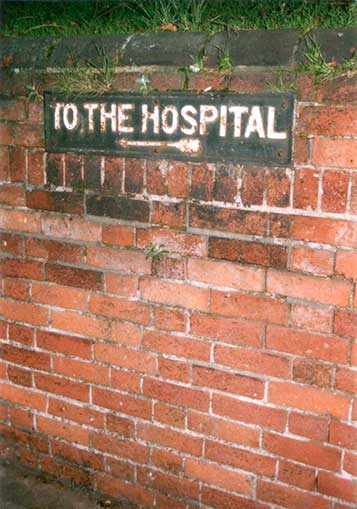 1997 image by the late John Norman
1997 image by the late John Norman
[UPDATE October
2024: The above photograph was found in the papers of our late friend
John Norman and we'd never seen this sign before. Comparing the
brickwork (note the course of edge-on bricks four courses down from the
capstones) with the retaining wall on the north side of Anglesea Road,
near to the Henley Road junction, this must have been the site of the
cast iron sign. An important direction to patients and visitors to
Anglesea Road Hospital a few hundred yards down the road, the sign
resembles a street nameplate – raised border with relief capitals and
the sort of arrow you wouldn't see today, all in reverse (white on
black). This photograph we can date to 1997, judging by the other
subjects John had photographed in the same paper wallet. That's six
years after the site had been redeveloped as a nursing home (see
below). The sign was probably removed a year or so after the presumed
date.]
Anglesea Road / Ivry Street
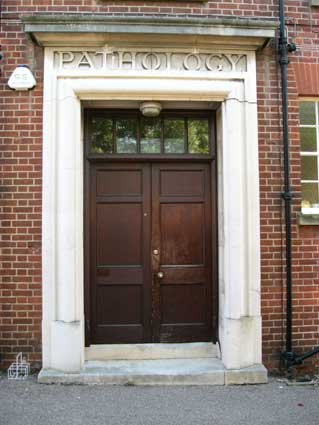
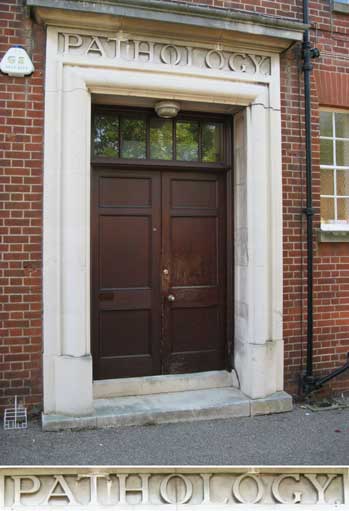 2012
images (unless shown)
2012
images (unless shown)
The art deco-style doorway above seems to echo the
doorways of Clifford
Road School that bear lettering of a similar vintage above them.
'PATHOLOGY'
This belonged
to the old Anglesea Road Hospital which stood above the top of Berners
Street.
This doorway is just off Ivry Street and is the side
door
(possibly now in use again, given the wire milk
bottle-carrier) of the present Institute of
Family
Psychiatry building. In July 2012 it certainly seems to have benefitted
from a clean up and coat of varnish from its sorry state about seven
years ago.
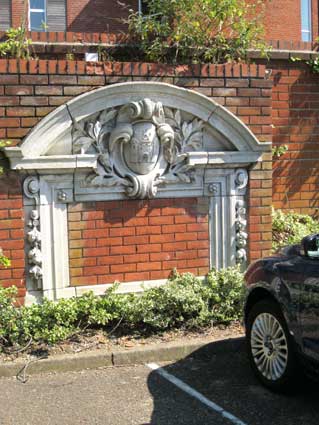
This classical style moulding built into the brick wall
is the first thing one notices in the car park next to the Pathology
doorway. Although devoid of lettering it bears a fantasy castle in
relief in the upper oval. Presumably the cuts in the stone arch enabled
its
extraction from the original hospital fabric.
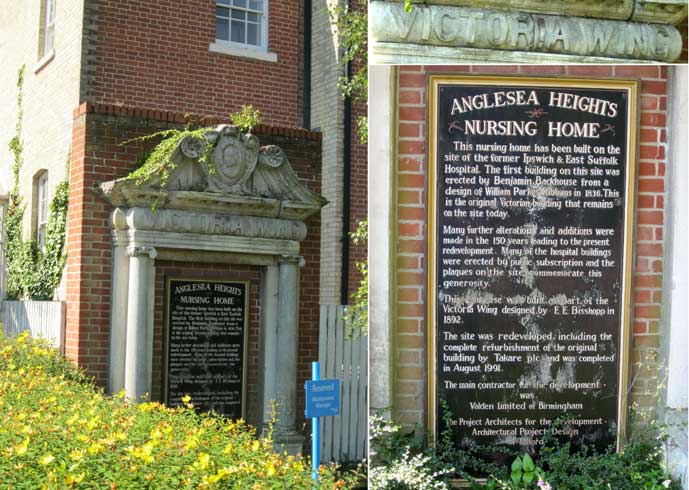
Not far from this door stands another, very different,
but related doorway.
Different in that it is less deco than baroque with its pillars and
mouldings, but
also
in that it leads nowhere, serving now only as a frame for the
plaque
commemorating
Ipswich and East Suffolk (Anglesea Road) Hospital and its conversion
into
'Anglesea Heights':
'ANGLESEA HEIGHTS
NURSING HOME
This nursing home has been built on the
site of the former Ipswich & East Suffolk
Hospital. The first building on this site was
erected by Benjamin Backhouse from a
design of William Parkes Ribbans in 1836. This
is the original Victorian building that remains
on the site today.
Many further alerations and additions wer
made in the 150 years leading to the present
redevelopment. Many of the hospital buildings
were erected by public subscription and the
plaques on the site commemorate this
generosity.
This doorcase was built as part of the
Victoria Wing designed by E.E. Bisshopp in
1892.
The site was redeveloped including the
complete refurbishment of the original
building by Takare plc and was completed
in August 1991.
The main contractor for the development
was
Valden Limited of Birmingham.
The Project Architects for the development
Architectural Project Design
of Telford'
As you can see from the detail below, the cameo
portrait of Victoria has all but eroded away. For another depiction of
Victoria above a doorway see the Victoria Free Library entrance on our
page about Ipswich
Museum.
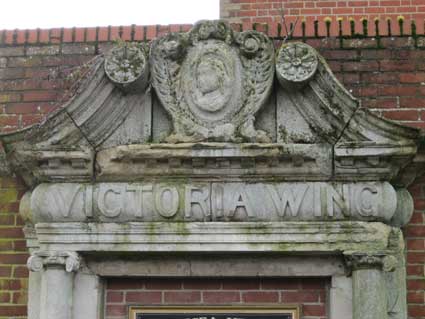 2014 image
2014 image
'VICTORIA
WING'
now stands in the car
park
where one or two other sculptural details including the fine
commemoration
plaque for the Ipswich War Memorial Wing
which stood on the site. See the historical note below.
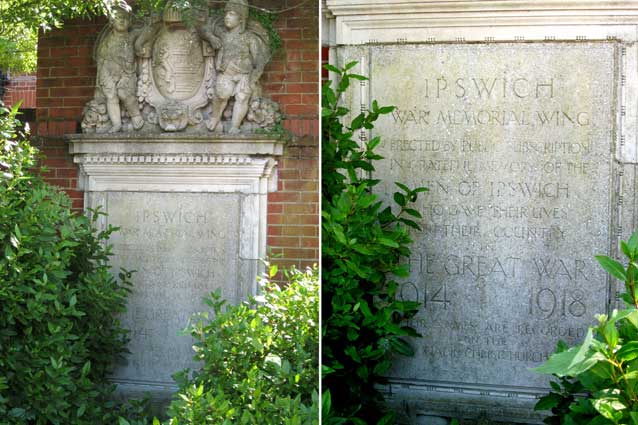
The text on the tablet reads:
'IPSWICH
WAR MEMORIAL WING
ERECTED BY PUBLIC SUBSCRIPTION
IN GRATEFUL MEMORY OF THE
MEN OF IPSWICH
WHO GAVE THEIR LIVES FOR THEIR COUNTRY
IN
THE GREAT WAR
1914
1918
THEIR NAMES ARE RECORDED
ON THE
[WAR] MEMORIAL IN CHRISTCHURCH [PARK]'

Another tablet can be found nearby which proclaims:
WAS PRESENTED BY
SIR BUNNELL H. BURTON
AND
SIR WILLIAM A. CHURCHMAN
IN THE YEAR OF THE CORONATION
OF
KING GEORGE VI'
Sir
Bunnell H. Burton donated the drinking fountain close to the
play area in Christchurch Park in
1896. Burton was a wholesale provision merchant based in College Street
and became prominent in the Burtons
dockside family firm. He was also organist of St. Mary-le-Tower Church,
Mayor of Ipswich in 1905, and for 38 years Chairman of the Governors at
Ipswich School. He was knighted in 1934 for political and public
services in Ipswich and died in 1943.
William
A. Churchman was born in Ipswich. He went into partnership with
his brother, Arthur (later a benefactor of Chantry
Park and Holywells Park to the town),
in the family tobacco firm which had been
founded by their great-grandfather in 1790. This was renamed W. A.
& A. C. Churchman. It was later absorbed by the tobacco combines
and Churchman became a director of the Imperial Tobacco Company.
Churchman was a staunch Conservative and was elected Mayor of Ipswich
in 1901. In 1911 he became a justice of the peace for Suffolk.
Churchman was commissioned Lieutenant in the 1st Suffolk Rifle
Volunteers (later 1st Volunteer Battalion, Suffolk Regiment) in 1885,
and promoted Captain in 1890 and Major in 1899. In 1905 he was granted
the honorary rank of Lieutenant-Colonel, in 1906 he was promoted
substantive Lieutenant-Colonel, and later that year he was granted the
honorary rank of Colonel. In 1908 he took command of the 4th Battalion,
Suffolk Regiment in the new Territorial Force. He retired in 1912, but
returned to command the battalion's recruiting section at the outbreak
of the First World War. He was later appointed director of the Nitrate
Section of the Ministry of Munitions. For these services he was
knighted in the 1920 New Year Honours. He was created a Baronet in 1938.
[UPDATE
22.5.2012:
"I was looking for information on a great lady I once worked with,
Sister Kitchener, and came upon your site. I worked as an orthoptist
with Mr Harry Hardy FRCS and Mike Parkinson FRCS at Anglesey Road prior
to the move to Heath Road Hospital in 1975/6. I was told that Sister
Kitchener was daughter of Lord Kitchener? She was probably Matron at
Anglesey road just before her retirement. I do not recall that she
moved down to Heath Road.
We were 'the eye clinic' at Anglesey Road and later Heath Road.
Unfortunately, I have no pictures of the hospital but remember the
entrance hallway, upon entering through the high wooden doors. There
were portacabins in the front then as space was at a premium. I had a
lovely two years working in Ipswich. I lived in Tattingstone while
there
after a short time lodging with a lady in Woodbridge Road whose
brother, Graham, had flown with Amy Johnson, or so she claimed!! They
were lovely days and my life began there, as I was a Welsh girl who had
broken out of the valleys mentality! My ex- husband was a student at
Essex University, studying politics with Tony King. The whole world was
ours! Ipswich football club were flying with Bobbie Robson as manager,
and Optician/Mayor (I believe) in Elm Street – can't recall his name,
was our optical assistant.
I now work in Ireland but will be retiring next year and may well
settle in Suffolk again. I am in touch with people who now live in the
beloved cottage I rented in Tattingtone, and will visit them in the New
Year ,hopefully.
I would have loved to send you pictures of the old hospital but, alas,
film was expensive. No digital then unfortunately!
Nice to remember good times again, Regards, Diana Owen, DBO." Many thanks to
Diana for getting touch via our email link.]
[UPDATE 1.4.2025: 'I have just
finished reading the fascinating article about the old hospital. I was
a frequent patient on Sinclair Ward under the care of Sister Kitchener
and Mr Hardy who were both very kind; as a child on the ward I
sometimes felt a little anxious. Sister Kitchener's father was, in
fact, a retired clergyman who lived in the Alms houses at the upper end
of Valley Road in Ipswich. I occasionally visited him with my father,
who knew both he and his daughter; both my parents worked at Anglesea
Road at different times. Jane Dowden-Knight.' Many thanks to Jane for adding her story
here.]
The above email prompted us to do a little more research (see Twinch,
Carol on our Reading List) on the old
Anglesea Road Hospital. The East Suffolk &
Ipswich Hospital &
Dispensary was built on Anglesea Road (see Street name derivations) in 1835 and the familiar portico
still catches the eye at the top of Berners Street, although the upper
storey was a later addition to the frontage. The original building cost
around £2,500 and stood in a high position overlooking the town
on about two acres of land purchased by the Trustees of the Revd. W.C.
Fonnereau surrounded by lawns, gardens and shrubberies. In 1918, as a
practical part of the Ipswich War Memorial to the Great War, a new wing
was added to the hospital on adjoining land on what had been the
Victorian Militia Depot. Plans were raised for the new extension and,
by 1924, the amount subscribed was £50,846 (of which £5,000
was allocated to the War Memorial in nearby Christchurch
Park. The Hospital closed and patient care moved to the newly-built
hospital on the site of the Heath Road Union
Workhouse, to the east of Ipswich, in the early 1980s.
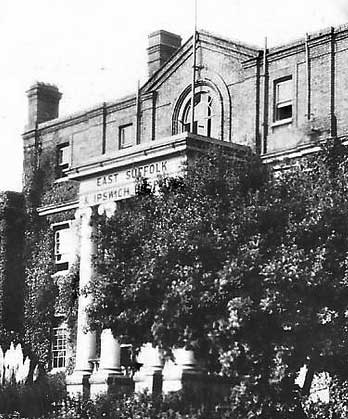 From an old
postcard
From an old
postcard
Until we saw this image (date unknown), we had
not realised that the hospital entrance, still so well known at the top
of Berners Street once bore the lettering on its lintel:
'EAST SUFFOLK
& IPSWICH HOSPITAL'
Below: two more photographs of the Hospital frontage (courtesy The Ipswich Society Image
Archive) show the early, two-storey building in the 1840s with
its prominent portico with Ionic columns and in the 1950s – after the
addition of a third
storey in 1869 – rather damaging the proportions of the building. Note
the fancier serif'd, drop-shadow capital lettering, compared to the
above photograph:
'IPSWICH
& EAST SUFFOLK
ANGLESEA
HOSPITAL WING'
with
'Anglesea Wing' set at an angle or on a slight 's'-curve (see detail).
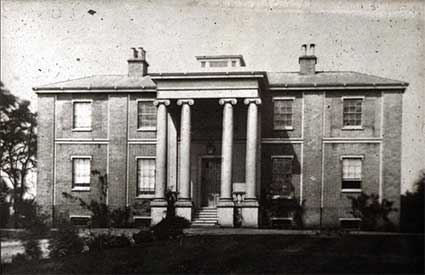
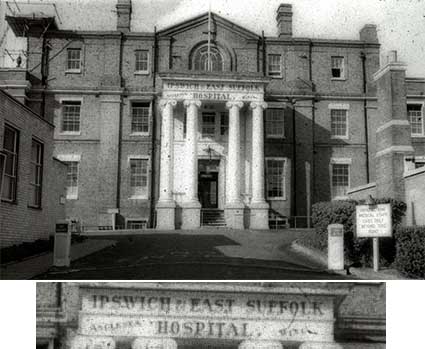
See also Heather Johnson's Great War Home
Hospitals site (see Links) for more
information about this hospital and wartime images
of the interior.
Great War British Home Hospitals
1914-1918: Home Hospitals, within 20 mile radius of Colchester
is a web-based project by Heather A. Johnson. Temporary Home Auxiliary
Hospitals were set up when the First World War began, in readiness for
wounded men arriving from ‘the Front’. The requisitioned buildings
were offered free of charge and included such places as schools, town
halls, village halls, hotels, convalescence homes, all manner of
private residences and wards set aside in civilian hospitals.
Ipswich hospitals covered include: ‘Broad Oke’, No. 7 Burlington Road;
Broadwater Auxiliary Hospital, Belstead Road; Gippeswyk Red Cross
(Isolation) Hospital; Heathfield Auxiliary Hospital, Heath Road; East
Suffolk & Ipswich General Hospital; Ipswich Military Hospital,
Ranelagh Road; Maryland V.A.D. Convalescent Hospital; Orwell Park
Auxiliary Hospital, Nacton; Wherstead Park Hospital, Wherstead;
Woolverstone Red Cross Hospital.
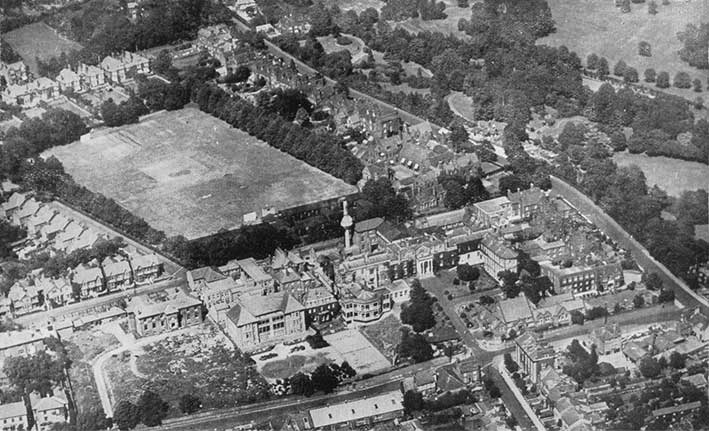 1934 image
1934 image
The above aerial view of Anglesea Road Hospital comes from Ipswich:
souvenir of the Royal Show July 3rd-7th 1934 and it shows
the state of Ipswich's hospital at that date with a plethora of
extensions and additions to the original buildings (most of this was
swept away when the old hospital site was rebuilt as Anglesea Heights
nursing home in 1991). Running diagonally
and dividing all the buildings from the Upper Arboretum in Christchurch
Park is Henley Road. The approach to the pillared portico is Berners
Street at lower right; the italiante former nurses home, which still
stands, is on the eastern corner with Anglesea Road. Running from left
to right above and below the
hospital site are Ivry Street and Angelsea Road respectively. Holly Road runs off
Ivry Street at an angle running along the edge of the public
school playing fields. The school buildings are on the corner of Ivry
Street running up
Henley Road, facing the park. St Edmunds Road can be seen at the upper
left. The Greyhound public house is just in shot at the extreme right.
Anglesea Road
Hospital lodge house

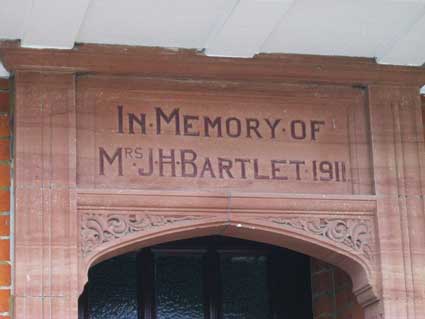 2013
images
2013
images
'IN.MEMORY.
OF
MRS. J.H.BARTLET.1911.'
There is an attractive
inscription over the door on the bungalow to the left of the entrance
to Anglesea Heights, formerly Anglesea Road Hospital where Dr J.H.
Bartlet
used to work (see St Peter's Hall following). Note the stylish double
bar on the 'H' and the decorative
spandrels below. Thanks to Mike O'Donovan for the St Peter's Hall
example and the next.
Incidentally, it is not clear what the present-day relationship is
between the Hall and the nearby St
Peter's Church which was built in
1460 (almost certainly on the site of an earlier church). The
church has been subject to a lottery-funded refurbishment and made into
a very welcome music venue; its former church hall is now residential.
St Peter's Hall. St Peter's
Street
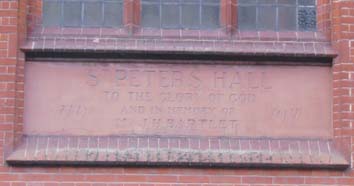
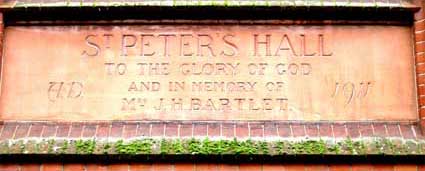 enhanced image
enhanced image
(Photograph
courtesy Mike
O'Donovan)
'S
T
PETER'S HALL
TO THE GLORY OF GOD
AND IN THE MEMORY OF
MRS J. H. BARTLET
A.D. .... 1911'
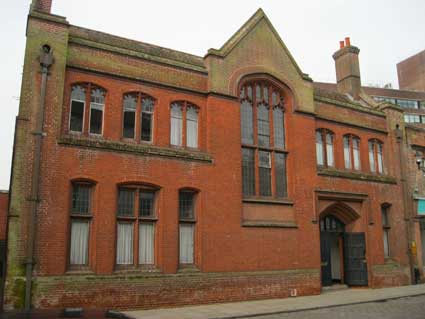 2014
image
2014
image
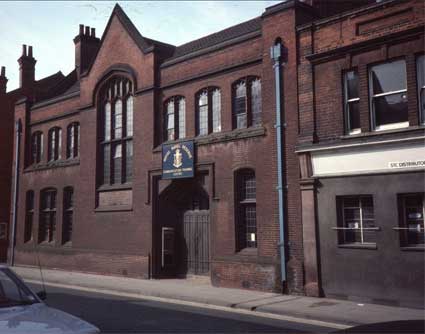 1985
photograph courtesy The Ipswich Society
1985
photograph courtesy The Ipswich Society
In 1985 the hall was used by the Royal Naval Reserve as a Communication
Training Centre.
There is a decorative rainwater hopper at the upper right of the
building, in line with the chimney stack:
'AD
1911'
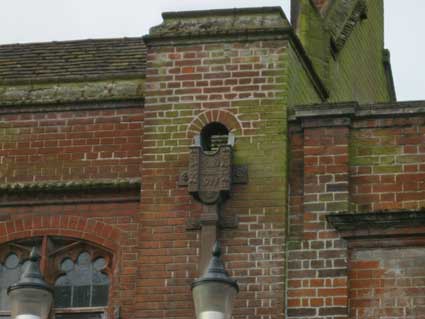
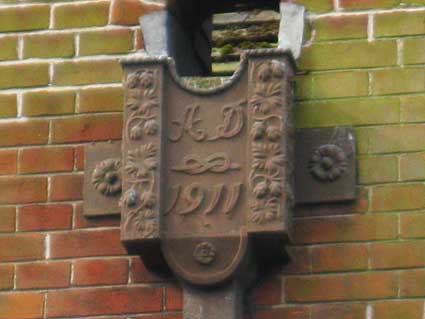 2014 images
2014 images
There is an identical rainwater hopper at the upper left corner:
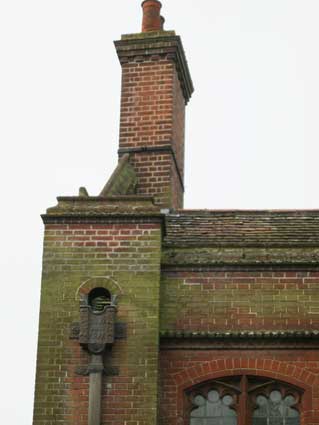
See our dated rain-hoppers page for
further examples.
'IPSWICH SANATORIUM'
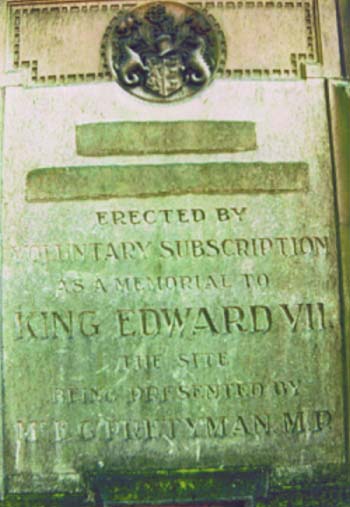
(Photograph courtesy
Mike
O'Donovan)
Mike O'Donovan writes: "I took
[the above image] a
good few years ago at the entrance to what was then Hightrees
Adolescent Unit off Foxhall Road on the outskirts of the town. It reads:
"Erected by voluntary subscription as a memorial to King Edward VII.
The site being presented by Mr. E. G. Pretyman, M.P."
I'm not sure if it still exists. The area is now the Nuffield [on the
other side of the road to the Foxhall speedway stadium]."
The blocked out lettering at the top of the tablet was conjectured to
read
'FOXHALL HOSPITAL' (although the spacing isn't convincing). We asked if
this tablet still exists... See UPDATES below for answers to both
questions.
The original Foxhall Hospital (the King Edward Memorial Sanatorium) was
built in 1912 as an isolation hospital for people with lung disorders,
particularly TB sufferers. After it closed down in 1975 it was used as
a centre for displaced Vietnamese “boat people” in the
early 1980’s. Suffolk Coastal District Council planners agreed to
the site being used again as a hospital-type facility after rejecting
housing proposals a number of times. Demolition of the original
hospital buildings started early in 1990 when developers began a
project to turn the building and its 19 acre site into a 58 bedroom
private hospital.
Download the Ipswich
Sanatorium 1912
EADT Souvenir book PDF file (48 pages) – opens in a new
window.
Foxhall is one of those names more associated with a road - which
begins at the top of Grove Lane in Ipswich and runs all the way to
Bucklesham - than a specific place, even though it was mentioned in the
Domesday Book in 1086. The Parish boundaries are very roughly:
- the Foxhall Road in the north
- the Ipswich- Felixstowe railway
to the south
- the A12/14 to the east
- the western boundary is formed by
the upper part of Mill River, wending through Brookhill Wood and
south to the Shepherd & Dog public House.
This last may come as a surprise to
those who wouldn't think of the Shepherd & Dog as being in Foxhall.
The Speedway stadium over the road from Foxhall Hospital, even though
it bears the name 'Foxhall' is actually in Kesgrave parish due to
boundary changes in 1984.
[UPDATE 6.10.2010: The original Foxhall Hospital (the King
Edward Memorial Sanatorium) Tablet - from Ross Greuber, to whom
our thanks. "I was interested in your article about the location of the
tablet. Unfortunately, the original hospital buildings have been
demolished, but the tablet with the inscriptions still survive, and
were transplanted to a little outhouse near the new hospital. It is
visible from the entrance to the main carpark, and can be accessed up
the steps leading to the main building. There is a feature inside the
Nuffield hospital of the original buildings in a picture frame in the
main waiting area. Hope this information helps. Ross"]
[UPDATE 18.11.2011: "I just
came across your website about historic lettering in Ipswich. The
blanked out part of the tablet that used to stand at the gate of
Foxhall Hospital read "Ipswich Sanatorium". The Sanatorium only
became "Foxhall Hospital" after the second world war. The name
was blanked out during the war just in case of invasion by the Germans
- to stop them from knowing where they were. For the same reason
many road signs were removed. However, there was another
identical tablet inside the grounds of the Sanatorium, which they
neglected to blank out! And that's how we know what it
said. I know this because I grew up in the grounds: my Dad
was superintendent of the hospital between 1951 and 1965.
Regards, Richard McNab"]
[UPDATE 16.10.2015: ‘Hi,
some years back I used to live in Hightrees itself; it was then a
children's home. Before that we were told that it was the doctor’s
house. Across the way from Hightrees was what we called the old
hospital which at the time was empty and, from time to time, we used to
get some boat people coming up the drive to visit the hospital. We had
to tell them it was no more in operation. I was sad to see the hospital
get knocked down. I have since found out that Hightrees had been sold
on and is still there. Robert Purnell’]
Many thanks to
these contributors,
particularly for the definitive eye-witness testimony.
For an intriguing historical footnote about Ipswich being put
beyond the pale by Queen Victoria and its bearing on the official
opening of Ipswich Sanatorium see the text from the 'Kindred Spirits'
website on our page dealing with the Suffolk
Victoria Nursing Institute in Lower Brook Street.
Perhaps we ought also to commemorate here the long vanished sign
further up the road which bore the legend 'FOXHALL ISOLATION HOSPITAL'. It
stood at the entry to a track leading off Foxhall Road across a
farmer's field about half way between the USAF aerial mast next to the
Bell Lane junction and the present Foxhall Recycling site. A large
building lurked in the trees, largely invisible when they were clothed
in leaves. It was also known to locals as the Smallpox Hospital. There
was the air of an institution deliberately remote from
everyday life. We believe that this is now a private residence.
St Clements Hospital
'S
t
C+B'
which we assume to stand
for 'St Clements Boundary'. Another such boundary
marker (below right) of carved stone stands by the east end of the main
wall of St Clements Hospital on Foxhall Road. This seems to bear a
similar, somewhat crudely cut, inscription with a '26' at the bottom.
For a gallery of such specimens see our Boundary
markers page.
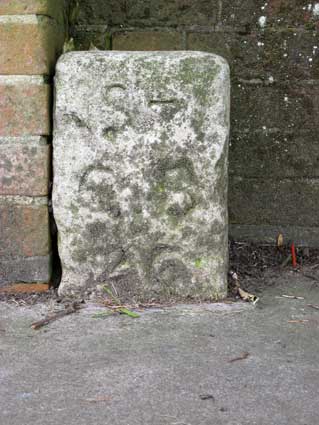 2012 image
2012 image
Mike O'Donovan sends some images about St Clements Hospital.
 Photographs below courtesy
Mike
O'Donovan
Photographs below courtesy
Mike
O'Donovan
Mike writes: "I used to work at St.
Clements Hospital
and was very lucky to get hold of some old photos, some of which were
taken in the 1880s. The attached one is a view of the back of the
hospital, which was then know as "The Ipswich Borough Asylum". The
original is a bit faded so I touched it up just a fraction. The
colour
one is a view of the hospital as it now looks."
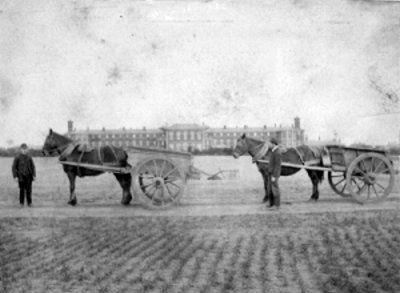
"The photo of the hospital grounds was taken in what is now the
football/cricket area. The golf course is more to the front of the
picture.
Regarding Dr. Chevallier, he was in charge of The Grove [an asylum just
off Grove Lane, finally demolished in the late 1980s] before becoming
the second Medical Superintendent of the Borough Asylum (St. Clements).
Here are some details of his life which you may find interesting.
He was born on January 17th 1819 and died on August 21st 1889. He
was educated at Charterhouse and was a Scholar of Brasenose
College, Oxford. He matriculated March 10th 1837. B.A. 1840. M.A. 1843.
B. Med. 1846. D. Med. 1852. M.R.C.P. (London) 1859. J.P. for the County
of Suffolk. Mayor of Ipswich 1874. Medical Superintendent of St.
Clements October 1st 1877 to August 21st 1889.
His father Revd. John Chevallier married three times. His second wife
was Dr. Chevallier's mother and his third wife was the mother of
Frances Anne Chevallier who married Lieutenant Colonel Henry Horatio
Kitchener. Their son was the famous "Your Country Needs You" Lord
Horatio Kitchener (1850 - 1916).
Not a lot of people are aware of the above info." Our Street Name page notes that Chevallier
Street, which runs between Norwich Road and Bramford Road, linking
Yarmouth Road and Valley Road ('the old by-pass'), commemorates Dr
Barrington Chevallier. For many years the Chevallier Club - a few doors
down from the Inkerman pub - which (regrettably) became commonly known
as "The Chev" - was a well-known night spot; it's now a restaurant.
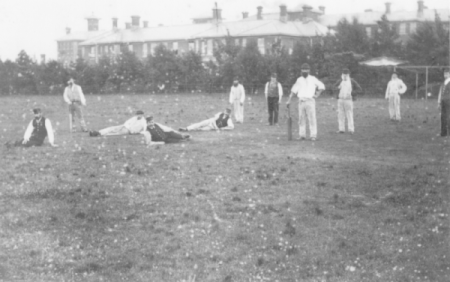
"Attached are two more photos from my collection. The first one has the
title "cricket field" on the back and the second one has the title
"Male Court M 1 July 28 1880". The originals are more of a sepia colour
and have some damage which I managed to repair in the copies. The
pictures are more than likely unique." Thanks to Mike O'Donovan for his
contribution.
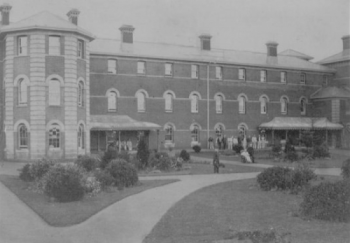
Home
Please email any comments and contributions by clicking here.
Search Ipswich
Historic Lettering
©2004 Copyright
throughout the Ipswich
Historic Lettering site: Borin Van Loon
No reproduction of text or images without express written permission

 1997 image by the late John Norman
1997 image by the late John Norman
 2012
images (unless shown)
2012
images (unless shown) 

 2014 image
2014 image

 From an old
postcard
From an old
postcard

 1934 image
1934 image
 2013
images
2013
images
 enhanced image
enhanced image  2014
image
2014
image 1985
photograph courtesy The Ipswich Society
1985
photograph courtesy The Ipswich Society
 2014 images
2014 images

 2012 image
2012 image Photographs below courtesy
Mike
O'Donovan
Photographs below courtesy
Mike
O'Donovan

